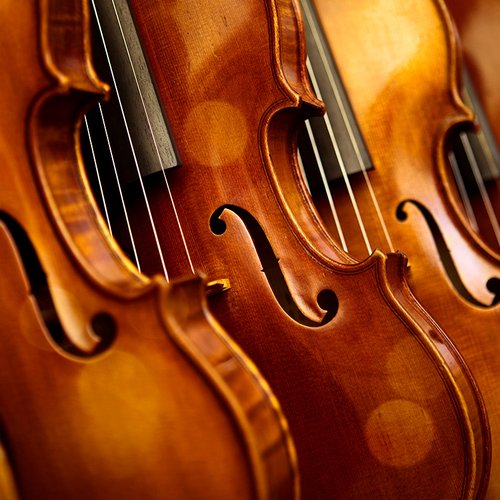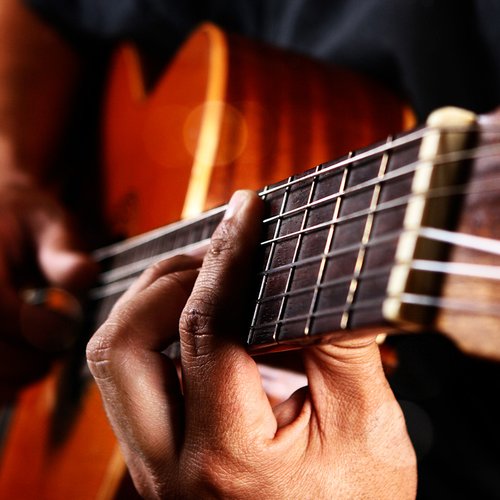What are the key differences between a classical and an acoustic guitar?
23 April 2025, 10:17

We explore the similarities and differences between the two common types of guitar.
Listen to this article
Acoustic and classical guitars look very similar, both made of wood, both with six strings, and both with the familiar guitar shape with a curved body and long neck.
But there are key differences that are very important to know about – from the material of the strings to the shape of the wooden body and fret board, which determine how the instrument sounds and what it is like to play.
Whether you’re planning to pick up a guitar to begin learning the instrument, or have simply always wondered what the differences between these two instruments are, read on to discover the key differences and similarities between the classical and acoustic guitars.
Read more: 10 beautiful pieces of classical music for guitar

Bach's Prelude in C for guitar - Raphaël Feuillâtre
Strings
One of the main differences between typical classical and acoustic guitars are the strings. Classical guitars have six strings made of nylon – a type of plastic that simulates the animal gut strings that instruments used to be stringed with. Acoustic guitars are typically strung with steel or other metal strings, which are brighter and more resonant than those of the classical.
Plucking
The different materials used for classical and acoustic guitar strings mean there are different ways to play the guitars. The softer nylon strings of the classical guitar are typically plucked with the fingernails or, in some cases, the soft fingertips, whereas acoustic guitar players more commonly use plectrums and picks, including the type of picks that are worn as rings around the fingers. Acoustic guitars can be played with the fingernails and fingertips too, though.
Tuning
The six strings of both the classical and acoustic guitar are tuned to the pitches, which are (from low to high) E A D G B E. Both guitars can be retuned so that their strings play different pitches, extending the melodic possibilities and altering the playability of certain keys.
Range
The typical range of both the classical and the acoustic are based on the pitches strings, and in standard tuning are from the low E string, to very high harmonics, making the range three-to-four octaves or more.
Read more: Guitarist MILOŠ names his five all-time favourite guitar pieces

Craig Ogden - Here Comes The Sun
Shape
Classical and acoustic guitars have very similar hourglass shapes, but if you look closely there are key differences. The wooden hourglass of the classical guitar has a top portion that’s only very slightly smaller than the lower portion of the instrument. Compare that to the acoustic guitar, and you’ll see that the acoustic has a much smaller top portion in proportion to the lower section. It’s a subtle difference, as is the difference between the sound hole: proportionately, the classical guitar has a slightly larger sound hole than the acoustic guitar. The fret board (the neck against which the strings are strung), of the classical guitar is significantly wider than that of the acoustic guitar.
Wood
The body of the classical guitar is typically made of rosewood, mahogany, or another type of hardwood, with mahogany for the neck and a darker mahogany for the fingerboard. The acoustic guitar uses similar hardwoods and sometimes the soft spruce.
Sound
Because of the different strings of the classical (nylon) and acoustic (steel) guitars, the sound between the two differs. The nylon strings of the classical guitar are more mellow and soft, while those of the acoustic guitar are more jangly and resonant, generally.
Headstock and tuning pegs
The tuning pegs of the classical and acoustic guitars are similar, but the headstock of the guitars are different. On typical instruments, the classical guitar has a carved, ornate head stock, which has symmetrical holes cut all the way through so you can see the pegs and intertwined springs poking through. Typically, the headstocks of acoustic guitars are solid, closed pieces of wood which conceal the work of the pegs and their tensing of the strings.
Other design features
The classical guitar differs from the acoustic in two further aesthetic ways. Because of the different types of strings the guitars use, the classical guitar doesn’t have the usually-plastic pickguard, or scratchplate, that the acoustic guitar has to protect the wooden body of the instrument from plectrum strums and the movement of the metal strings. And the classical guitar has an unmarked ebony neck, while the acoustic guitar features fret markers, small white dots in various pairs, groups or single formations on alternate frets of the guitar, to help the player find common chords and pitches.
Musical genres
The classical and acoustic guitars’ differences mean they lend themselves typically to different genres of music. Spanish and flamenco, as well as Western classical, music lends itself beautifully to the classical guitar, while the strident and textured sounds of pop and rock genres can often be best served by the resonant sound of the acoustic.

























